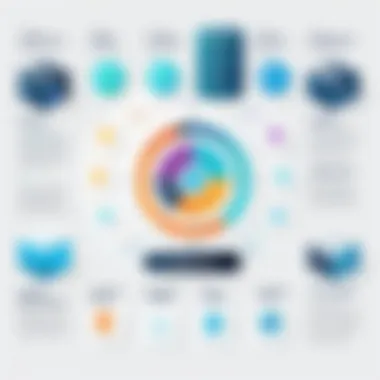Understanding Acuity Scheduler: A Comprehensive Exploration


Intro
In the realm of appointment scheduling, having the right tool can make a significant difference for businesses. Acuity Scheduler emerges as a notable option within this category, designed to streamline the process of managing appointments effectively. This comprehensive exploration will not only highlight its unique features but also provide insight into how it compares with other solutions on the market. By understanding Acuity Scheduler's capabilities, businesses can make more informed decisions about integrating it into their operations.
Software Category Overview
Purpose and Importance
Appointment scheduling software like Acuity Scheduler plays a critical role in various industries. From healthcare to service-based businesses, effective appointment management helps optimize time, reduces no-shows, and enhances customer satisfaction. This software addresses the complexities of coordinating appointments by offering automated solutions that are both user-friendly and efficient. The importance lies in its ability to adapt to different business needs and improve overall operational efficiency.
Current Trends in the Software Category
The landscape of scheduling software is evolving rapidly, influenced by technological advancements and changing business practices. One prominent trend is the integration of artificial intelligence and machine learning to enhance user experience. These technologies help in predicting scheduling patterns and automating reminders. Additionally, there is a marked shift toward cloud-based solutions, providing accessibility and scalability for businesses of all sizes. Companies are also increasingly opting for solutions that integrate seamlessly with existing platforms, such as CRM systems and payment processors.
Data-Driven Analysis
Metrics and Criteria for Evaluation
Evaluating an appointment scheduling tool like Acuity Scheduler involves several key metrics. These include:
- User Interface: A clean and intuitive design that promotes ease of use.
- Integration Capability: The ability to work with other tools and platforms.
- Customization Options: Flexibility to adapt the software to specific business needs.
- Customer Support: Availability of reliable support during implementation and troubleshooting.
- Pricing Structure: Cost-effectiveness relative to the features offered.
Comparative Data on Leading Software Solutions
When comparing Acuity Scheduler to other leading solutions like Calendly or Square Appointments, several factors come into play. Acuity Scheduler is known for its robust customization features and comprehensive calendar management options. In contrast, tools like Calendly emphasize simplicity and quick setup, which may serve different business priorities.
"Selecting the right scheduling tool must consider specific business requirements and how well the solution integrates within existing workflows."
Ultimately, the right choice depends on evaluating how each tool aligns with distinct business goals and user needs.
Foreword to Acuity Scheduler
Acuity Scheduler serves as a vital tool in today's fast-paced business environment. As companies increasingly rely on efficient time management, the relevance of sophisticated scheduling solutions cannot be overstated. Many organizations, from startups to established enterprises, can benefit from a system that streamlines appointment booking, provides insightful analytics, and enhances client interaction.
Effective scheduling software can significantly improve organizational productivity, reduce administrative burdens, and elevate client satisfaction. In this context, Acuity Scheduler stands out due to its versatile features designed to cater to diverse business needs.
The ability to customize appointment types and automate scheduling processes is essential for businesses aiming to optimize their resources and enhance client engagement.
Not only does it simplify the appointment-setting process, but it also facilitates seamless integrations with third-party platforms. This article aims to provide a comprehensive view of Acuity Scheduler, highlighting its key features, benefits, and challenges. By delving into this exploration, technology professionals and business leaders alike can make informed decisions about incorporating this tool into their operations.
Overview of Scheduling Software
Scheduling software encompasses a variety of tools designed to assist with the management of appointments and meetings. As businesses expand, the task of coordinating schedules can quickly become overwhelming. Here lies the necessity for systems that automate this process, ensuring efficiency and accuracy. Typical features of scheduling software include calendar integrations, availability tracking, and automated reminders.
For many organizations, the transition to digital scheduling tools means minimizing scheduling conflicts and maximizing productivity. While the market offers various options, the effectiveness of a scheduling solution largely depends on how well it aligns with specific business workflows. Features such as user-friendly interfaces and customizable options are essential for a successful implementation.


Purpose of Acuity Scheduler
The primary purpose of Acuity Scheduler is to provide a comprehensive scheduling solution that meets the demands of diverse users. This software aims to reduce the complexity of appointment booking while enhancing the overall client experience. With Acuity, businesses can create various appointment types, making it easy to cater to client needs, whether they require consultations, meetings, or classes.
In addition to this flexibility, Acuity Scheduler automates appointment confirmations and reminders, significantly reducing no-show rates. By enabling businesses to manage their time more effectively, Acuity Scheduler not only improves internal processes but also fosters stronger client relationships. Its analytics and reporting capabilities allow professionals to gain insights into their scheduling trends, facilitating data-driven decision-making for improvements.
Core Features of Acuity Scheduler
The core features of Acuity Scheduler set it apart in the crowded market of scheduling tools. Understanding these features is crucial for businesses looking to optimize their appointment management systems. Each feature serves a specific purpose, aimed at streamlining processes and improving user experience. Focusing on these aspects can lead to better operational efficiency and customer satisfaction.
User Interface and Experience
Acuity Scheduler boasts a user-friendly interface, making it accessible for users of all skill levels. The layout is intuitive, allowing users to navigate easily through various options without getting overwhelmed. It emphasizes simplicity while providing robust functionality. The design incorporates a responsive layout, making it compatible with various devices, including smartphones and tablets.
The experience is further enhanced by customization options that allow users to tailor their dashboard to suit their preferences. This adaptability of the user interface makes it appealing for businesses, whether they are small startups or large corporations. Having a positive user experience can drastically reduce the time spent on training and onboarding, contributing to overall productivity.
Customizable Appointment Types
One main feature of Acuity Scheduler is its ability to offer customizable appointment types. Businesses can create multiple appointment categories based on their specific needs. For instance, a therapist can have different session types, such as initial consultations or ongoing therapy sessions, each with its duration and pricing.
This customization allows businesses to cater to their unique workflows and service offerings. Being able to specify appointment types ensures that clients have clarity on what to expect, which can improve the booking process. It also allows the business to manage schedules more effectively, preventing overbooking or double-booking scenarios.
Integrations with Other Platforms
Integrations are a vital component of Acuity Scheduler's offering. The ability to connect with various platforms enhances its functionality and makes it a versatile tool for businesses. Here, we will discuss three types of integrations:
Calendar Integrations
Calendar integrations allow Acuity Scheduler to synchronize with popular calendars like Google Calendar and Microsoft Outlook. This synchronization helps users keep their schedules organized across different platforms. They can view all appointments in one place, minimizing the risk of conflicts.
A key characteristic of calendar integrations is their real-time updates. When a client books an appointment, it automatically reflects in the connected calendar. This feature eliminates the need for manual entry, saving time and reducing errors. For busy professionals, this functionality is particularly beneficial.*
"Acuity Scheduler's calendar integrations are revolutionary for maintaining an organized schedule in real-time."
Payment Processing Integration
Payment processing integration is essential for businesses that require upfront payments or deposits for their services. Acuity Scheduler offers integration with platforms like PayPal and Stripe, making transactions straightforward.
This feature's key characteristic is its ease of use for both clients and businesses. Clients can pay directly through the scheduling tool, which can enhance their booking experience. However, businesses should consider transaction fees associated with these platforms, as it can affect overall profitability.
Third-Party App Connections
Acuity Scheduler supports connections with various third-party applications, ranging from marketing tools to Customer Relationship Management systems. This capability allows for an interconnected workflow, further automating tasks that would otherwise be time-consuming. For instance, connecting Acuity Scheduler with Mailchimp can streamline email marketing campaigns for follow-ups.
The key characteristic of these connections is flexibility. Businesses can choose which tools work best for their operations without being locked into a specific ecosystem. However, it is important to ensure that these connections are reliable and that data synchronization works seamlessly to avoid disruptions in service.
Benefits of Using Acuity Scheduler


Using Acuity Scheduler provides various advantages that enhance appointment management for businesses of all sizes. The ability to streamline scheduling processes, improve customer interaction, and analyze performance is crucial in a competitive landscape. Businesses that adopt this tool can expect not only operational efficiency but also insights that drive strategic decision-making. Let's examine the principal benefits provided by Acuity Scheduler in detail.
Improved Efficiency
One of the standout benefits of Acuity Scheduler is its capability to significantly improve efficiency in managing appointments. This software automates many of the routine aspects of scheduling, allowing users to focus on more critical tasks.
- Automated booking: Clients can schedule their appointments online at their convenience. This reduces the need for back-and-forth communication between clients and staff.
- Time management: The tool allows for effective time blocking. This helps in maximizing the utilization of resources available for appointments.
- Reduced no-shows: Custom reminders can be set up to notify clients about their upcoming appointments. This proactive communication reduces no-show rates, making better use of a business’s time.
The aforementioned factors contribute to a productive environment, as staff members can dedicate their efforts to more pressing responsibilities rather than handling administrative tasks.
Enhanced Client Experience
Acuity Scheduler enhances the client experience in several important ways. It ensures that customers feel valued and respected throughout their interactions.
- Self-service capabilities: Clients can select appointment times that suit them directly from available options.
- Personalized communication: The platform allows for customized interactions, from confirmation emails to follow-ups. Clients appreciate personalized touchpoints that reflect attentiveness.
- Flexible scheduling options: The ability to handle different appointment types and durations means customers find it easier to get precisely what they need.
Overall, a better client experience leads to increased satisfaction. Satisfied clients are more likely to return and recommend services to others, which is vital for business growth.
Access to Analytics and Reporting
Acuity Scheduler also provides businesses with access to valuable analytics and reporting capabilities. These insights can guide companies in refining their scheduling practices and making informed business decisions.
- Performance metrics: Detailed reports help in analyzing appointment trends, cancellation rates, and client engagement levels.
- Revenue tracking: Understanding which services generate the most revenue over time helps businesses allocate resources more effectively.
- Client demographics: Businesses can access data about client preferences and behaviors. This information can be utilized for targeted marketing efforts.
Insight through analytics is a cornerstone of strategic improvement in businesses today.
The analytics offered by Acuity Scheduler allows for insightful assessments and data-driven planning, which is essential for sustained growth.
In summary, leveraging Acuity Scheduler can lead to improved efficiency, enhanced client interactions, and superior access to crucial analytics. These combined advantages position businesses favorably in a competitive market.
Challenges of Implementing Acuity Scheduler
In any business, adopting new technology comes with challenges. Implementing Acuity Scheduler is no exception. Understanding these challenges is crucial for successful integration. This insight helps businesses prepare and navigate potential pitfalls while reaping the benefits of the software.
Learning Curve for Users
One significant challenge is the learning curve for users. While the interface of Acuity Scheduler is designed to be intuitive, users still need time to familiarize themselves with its features. Training is essential to ensure that all team members can operate the system effectively. A lack of proper guidance can lead to frustration and decreased productivity.
New users may struggle with concepts such as managing appointment types, setting availability, and understanding client notifications. This is especially true for individuals unfamiliar with digital scheduling tools. Organizations must allocate time for training sessions and provide accessible resources. This ensures that every user can become proficient in using Acuity Scheduler.
- Consider establishing a training program.
- Create easy-to-follow documentation.
- Host Q&A sessions to address common queries.
Employees should feel supported throughout this learning phase. Incorporating feedback on the learning process can also help refine training methods. Making this investment can enhance user comfort and command from the outset.
Reliability and Technical Issues
Another notable challenge involves reliability and technical issues. As with any software, users may encounter bugs or downtime. This can disrupt business workflows and client interactions. Therefore, understanding the limits of the system is important.


Potential technical issues could include:
- Server downtime: This can lead to lost appointments or scheduling errors.
- Integration failures: Problems might arise while connecting Acuity Scheduler to other platforms like Google Calendar or payment processors.
To address these challenges, businesses must establish a contingency plan. Regularly reviewing system performance is advisable. Keeping updated with software patches and enhancements play a key role in ensuring smooth functioning.
Additionally, customer support should be readily available. It can assist users experiencing difficulties. Access to a reliable support system can mitigate some of the pressing issues, fostering a more secure implementation experience.
"Preparation and proactive measures can significantly reduce the impact of challenges associated with implementing Acuity Scheduler."
Best Practices for Using Acuity Scheduler
Using Acuity Scheduler effectively requires understanding some best practices that can enhance its value in managing appointments. These practices not only streamline processes but also optimize the overall experience for both the users and the clients. Focusing on specific elements such as customization, training, and feedback is crucial. By adhering to these strategies, businesses can maximize the potential of Acuity Scheduler and ensure a smooth operational flow.
Customization Strategies
Customization is a key aspect of utilizing Acuity Scheduler effectively. Tailoring the scheduling system to fit the unique needs of a business allows for a more intuitive and efficient experience. Consider the following strategies for successful customization:
- Personalized Appointment Types: Define various appointment types specific to services offered. Each type can have its own duration, buffer times, and availability, ensuring that clients know exactly what to expect based on their selection.
- Branding Elements: Incorporate company branding into the scheduling interface. Adding logos and color schemes can create a cohesive brand experience that reinforces professionalism and enhances client trust.
- Customized Notifications: Use tailored confirmation and reminder messages. Setting up these notifications helps in minimizing no-shows and keeps clients informed about their appointments in a way that resonates with them.
Customization not only improves the user experience but also allows businesses to convey their identity in a concrete manner.
Ongoing Training and Support
Another critical best practice involves continuous training and support. Given the evolving nature of software tools like Acuity Scheduler, it is vital for users to remain updated on features and functionalities. Key elements to consider include:
- Regular Training Sessions: Organize consistent training for staff to ensure they are well-versed in all aspects of the software. Sessions could cover new updates, advanced functionalities, and effective use cases.
- Access to Resources: Provide users with access to manuals, online tutorials, and user forums. Utilizing platforms such as reddit.com for community support can also furnish additional insights.
- Dedicated Support Team: Establish a support system for immediate assistance on technical issues or inquiries. Quick resolutions to problems inspire confidence and less frustration for end-users.
Ongoing support and training help ensure high levels of user engagement and proficiency with the platform, helping to alleviate potential challenges down the line.
Feedback Mechanisms for Improvement
Implementing feedback mechanisms is essential for continual improvement. Harvesting insights from users regarding their experiences can drive enhancements and elevate the service level. Possible feedback strategies include:
- Surveys and Questionnaires: Collect information post-appointment via surveys. This data can pinpoint areas in need of improvement or highlight aspects that are functioning well.
- Regular Check-ins: Schedule periodic check-ins with users to discuss their experiences and gather real-time feedback. This creates an open line of communication, inviting users to share their thoughts proactively.
- Analytics Review: Utilize built-in analytics to track booking patterns and client behavior. Reviewing these reports can highlight trends and suggest areas for adjustment.
Feedback is not only about rectifying flaws; it is also about recognizing success and maintaining ongoing improvements.
Culmination
In today's fast-paced business environment, effective scheduling is crucial. The Acuity Scheduler stands out as a prominent solution for various appointment management needs. By integrating its robust features with user-friendly design, it caters to a wide range of professionals and businesses. Understanding the significance of using an advanced appointment scheduling tool is vital for organizations looking to streamline operations and improve customer satisfaction.
Future Prospects of Acuity Scheduler
Looking ahead, the future of Acuity Scheduler appears promising. As technology continues to evolve, the demand for intuitive scheduling solutions will likely grow. Features like enhanced AI capabilities, better integration with emerging apps, and real-time analytics are anticipated developments. This will enable users to manage scheduling tasks more efficiently and expand their client base with targeted marketing strategies.
Furthermore, adapting to new business needs will be an ongoing process. The trend toward remote work is also reshaping how appointments are scheduled. Virtual consultations and bookings may become more prevalent. As such, Acuity Scheduler’s flexibility to incorporate new tools will solidify its position in the market.
Final Thoughts on Adoption
Adopting Acuity Scheduler can mark a strategic move for businesses seeking to optimize their appointment management. The implementation of such a tool requires careful consideration. Factors to weigh include the possible learning curves for staff and the technical support necessary during transition. Making informed decisions based on specific business needs is essential.
Ultimately, the success of the adoption hinges on the willingness to engage with the platform and maximize its offerings. Regular training and feedback mechanisms can pave the way for improved user proficiency. Recognizing the tool's full potential will not only enhance efficiency but also strengthen client relationships, ensuring that businesses stay ahead of the curve.







